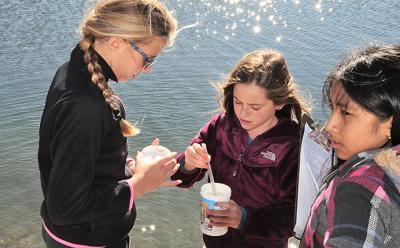Students Take on the Estuary

Students from the Springs and East Hampton School Districts got their feet wet — some in the literal sense — as citizen scientists taking part in a Day in the Life of the Peconic Estuary, an annual program that brings together hundreds of students to work collectively to create a snapshot of life in the bay.
Students worked in small groups on Oct. 23 alongside environmental educators at sites including Northwest Harbor County Park, Louse Point, and Lazy Point to record data and make observations. They stood on the shores and measured aspects of water quality such as acidity, temperature, and oxygen level, and studied sedimentation and tidal activity. Some even donned waders and pulled seines through the water to catch fish and shrimp, allowing the groups to build a biodiversity inventory.
“The entire Peconic Estuary is an estuary of national significance,” said Robert Schack, a science teacher whose East Hampton High School classes participated in the event. “It does have its water quality issues for sure, but it’s one of the most intact ones that there is. The entire study that’s going on is a sample of what’s happening right now at this moment in time, something that’s very difficult for a small number of scientists to do, but citizen science can do a lot at once.”
The event’s numerous sponsors, including the Central Pine Barrens Joint Planning and Policy Commission and the Suffolk County Water Authority, described it as “not just a mere field trip.” At the Springs School, the mission resonated with Sean Knight’s fifth-grade science classes and Robert Walker’s seventh-grade science classes.
“We got to dig our hands through the mushy sand and water and try to find life, like fishes, clams, and shrimp,” said Alma Chacon, a fifth-grade student. “It was so much fun.”
“It was different because it was more than just the teacher and you,” said a classmate, Jameson Grant. “It was a group project. We all had to work together. . . . “
It was the second year that Mr. Knight’s students participated in the program. “When they go out there, they realize they are doing it for a purpose,” he said.
In the weeks leading up to the day in the bay, the teachers taught their students how to use some of the instruments involved in collecting information. Some teachers, like Mr. Knight and Mr. Schack, have aquariums in their classrooms that could be used by students to practice their measuring skills. The project had those fifth graders throwing around science phrases like “pH balance” and “dissolved oxygen,” which affects the water’s acidity, tand “range of tolerance,” meaning the various conditions under which organisms can thrive or merely survive.
Mr. Schack said the project gave his classes a deeper appreciation for the local environment and, specifically, perspective on Northwest Harbor, a place the kids have most likely been to for swimming or recreation.
“It’s beautiful, and they’ve played here, most of them, but they don’t know about the creatures who live here,” he said. “It’s the baseline for the rest of the year. So now, instead of studying the chemicals and it being this nebulous, foreign concept, we start out with the ecosystem. We’ve measured these things, so we can explain how these things actually have an effect.”
In the weeks leading up to the East End students’ day on the Peconic Bay, students from UpIsland school districts were busy doing the same activities at places along the Carmans River, Connetquot River, and Nissequogue River. All of the students’ measurements can be seen on a web page hosted by Brookhaven National Laboratory, portaltodiscovery.org/aday/.
“If you think your way through and apply good science, which is what this is, we can fix these problems,” Mr. Schack said. The broader spectrum is that if there is a problem here . . . we know how to fix it, address it, and preserve the biodiversity as well.”
Emily Kennedy, a fifth-grade Springs student, expressed a similar sentiment. “I feel like I can go home and do my own experiments,” she said. “My favorite part was that it was a hands-on project. It let us know what we have to do to change the environment in a good way.
